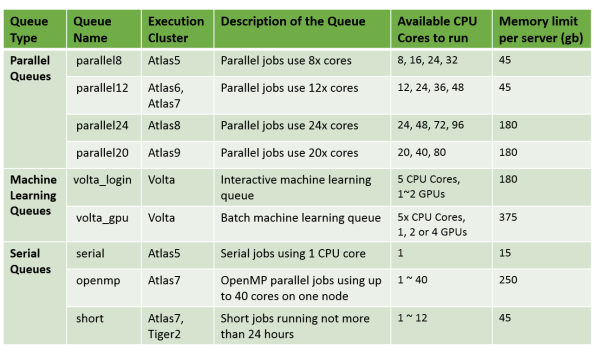Introductory Guide for New HPC Users
As a new user, when you registered a HPC account, the first thing you want to know may include one or more of the following:
• Which hosts can you login and what is the best ways to access the hosts remotely?
• How to transfer files between the hosts and your PC or another Unix system in your lab?
• After you login to one of the host, which directories can you use to run your jobs?
• What are the batch PBS queues for running long hours computing jobs?
This introductory guide is to answer those questions. Together with the relevant links provided, we hope that it will help you to get started smoothly.
At HPC, all systems are managed by the PBS Job scheduler. With the PBS commands, you can submit your jobs to different hosts with different features, capabilities and limitations. You can monitor your jobs while they are running or check the load and status of each host to choose your submission queues and hosts. Therefore, before you start your work, do check the PBS Use Guide (NUS internal link) in HPC home page or read the man pages (type man followed by the command) for different commands to familiarize yourself with PBS commands and the queues and hosts (NUS internal link) used in the PBS environment. Please note that interactive jobs and background jobs submitted with the ampersand (&) have a CPU limit of 30 minutes, they will be terminated after they reach this limit. The recommendation is to submit all compute-intensive jobs as batch jobs through the PBS.
Some users are new to the Linux operating system. To learn more about Linux, you can read books on Linux; or simply type a “linux commands” in the internet search engines to search, you will get dozens of web pages with listing and explanation of Linux commands. A compiled list of the Linux commands is also available here for your reference, click here to download.
As a new users, you may have problems with our system or software from time to time, the HPC home page is at your fingertips all the time. Check different pages to find solutions for your problems.
Please provide through nTouch a more specific description of your problems with error messages and so on that will help us in investigating and solving the problems.
Wishing you enjoy using HPC resources!
HPC Account
HPC resources are open to all NUS staff and students who have a valid NUS-ID with the need to access high-performance computing resources.
- Click here to read the procedure and start registration.
- After registration, wait for about 1 hour, you will be able to use the userid and password to access all HPC resources. The NUS-ID password is valid throughout all the hosts.
- As the access control and authentication of all HPC servers are through NUS-ID account, change of NUS-ID password will automatically take effect on all HPC servers.
- You are using your NUS-ID account to access HPC services. You can change your password at exchange.nus.edu.sg.
Accessing HPC Hosts
At HPC, we provides various kinds of compute servers and graphical workstations to meet the users’ requirements for different hardware platforms and operating systems. The compute servers are used to run time-consuming compute intensive jobs, while the graphical workstations can be used to do the pre- and post-processing works and graphical display.
The follows are different ways to access these hosts:
From any Unix/Linux system on campus
Use ssh plus the hostname/ip address to access the following hosts/clusters:
| Hostname | Note |
| atlas6-c01.nus.edu.sg | HP Xeon two sockets Hexa-Core 64-bit Linux cluster, CentOS 6 |
| atlas7.nus.edu.sg | HP Xeon two sockets Hexa-Core 64-bit Linux cluster, CentOS 6 |
| atlas8.nus.edu.sg | HP Xeon two sockets 12-Core 64-bit Linux cluster, CentOS 7.8 |
| atlas9.nus.edu.sg | HP Xeon two sockets 20-Core 64-bit Linux cluster, CentOS 7.5 |
From any PC using Internet Explorer or Firefox web browser
Using SSH or PuTTY Client:
Download PuTTY or MobaXterm Home-Edition and install it on your PC and use them to access the HPC hosts.
To access the graphical workstations remotely
Launch graphical applications on the powerful workstations and display on your desktop via the HPC Portal. The user guide is available here.
File Transfer
From any UNIX/Linux system on campus
Secure FTP is recommended for file transfer, please check the availability of scp or sftp.
On Windows system
• User’s home directory is mounted to U: drive when login to NUS domain. You can transfer files to your HPC home directory by drag and drop files in a Windows Explorer.
• If your computer is not joined to NUS domain, you can mount your HPC home directory (\\hpcnas.nus.edu.sg\svu\username) from a Windows Explorer only. If you are outside of campus, please use the method below for file transfer.
• Using SFTP in PuTTY, Filezilla, or other secure File Transfer Tool (instruction).
Working Directories
After login to any of above hosts, you will be able to access the following directories.
| Directories | Feature | Disk Quota | Backup | Description |
|---|---|---|---|---|
| /home/svu/$USERID | Global | 20 GB | Snapshot | Home directory, U: drive on your PC. The longest snapshot backup is 10 days. |
| /hpctmp | Local on All Atlas cluster | 500GB | No | Working directory. Files older than 60 days are purged automatically. |
Details and instructions on how to use the working directory /hpctmp and /hpctmp2 is available at the page of the High Performance Workspace for Computational Clusters.
• Type “hpc s” to check your disk quota for your home directory, use “df -h” command to check the free space left in a file system.
• Please do house-keeping work from time to time to make sure your disk quota is not exceeded, otherwise, you’ll have problems to access HPC hosts and run jobs.
• More disk quota is granted if there is a need, submit the service request form for your request.
Queues & Hosts for Submitting Jobs
Users are required to submit their time-consuming jobs to the compute servers through PBS batch queue system, instead of just submitting to the background with an ampersand (&) or running interactively in the foreground. Different hosts accept jobs from different batch queues. The following is a list and description of hosts and batch queues, for details, please check the PBS Guide on the Technique Information page.

Linux Command
HPC hosts are all running Linux operating systems, being familiar with Linux command will surely help you in your work. There are many ways to learn more about Linux:
• Linux books from library
You can find many books on Linux concepts and commands at the library.
• Web pages in the internet
Search the internet with key words like “Linux command”, you will get dozens of web pages listing the Linux commands.
• You can download the following command summary for your reference
HPC Home Page
Remember to check the HPC home page for any information regarding HPC resources and services.
For problems or queries, please contact us through nTouch (search for “HPC Enquiries”).

